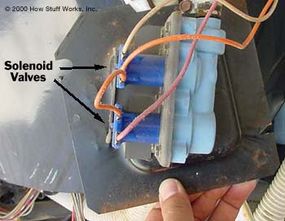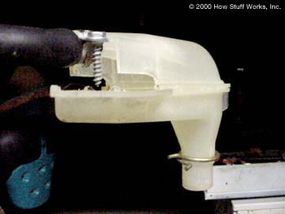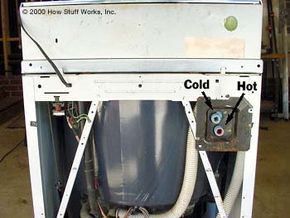Plumbing
The plumbing on the washing machine has several jobs:
- It fills the washing machine with the correct temperature of water.
- It recirculates the wash water from the bottom of the wash tub back to the top (during the wash cycle).
- It pumps water out the drain (during the spin cycle).
The washing machine has hookups for two water lines on the back, one for hot water and one for cold. These lines are hooked up to the body of a solenoid valve.
Advertisement

The image above shows the back and front of the solenoid valve. You can see that there are two valves, but they feed into a single hose. So depending on the temperature selected, either the hot valve, the cold valve or both valves will open.
Before the hose releases water into the wash tub, it sends it through an anti-siphon device.

This device prevents wash water from being sucked back into the water supply lines, possibly contaminating the water for your house or even your neighborhood. You can see that the white, plastic device has a big opening that allows air in. The water from the hose shoots into the device and turns downward, exiting through the tube on the other end. But while it is inside the device, it is open to the atmosphere. This means that if there were suction on the water supply line, it could not possibly suck any water in from the washing machine; it would get only air.

The picture above shows the inlet through which water enters the washing machine. The nozzle to the right is an overflow port, which is connected to a pipe that dumps water out the bottom of the washing machine (onto your floor), instead of letting it overflow the tub and possibly get the motor wet.
